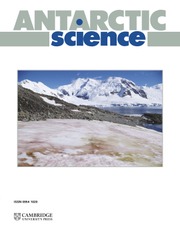Crossref Citations
This article has been cited by the following publications. This list is generated based on data provided by
Crossref.
Martorell, Maria Martha
Ruberto, Lucas Adolfo Mauro
de Figueroa, Lucía Inés Castellanos
and
Mac Cormack, Walter Patricio
2019.
Fungi of Antarctica.
p.
285.
Gaiser, R. F.
Robles, C. A.
Kobashigawa, J. M.
Pereira, S.
Skronski, N.
and
Carmarán, C. C.
2021.
Mycobiota associated to Casa Moneta Museum wood, South Orkney Islands, Antarctica.
Polar Biology,
Vol. 44,
Issue. 9,
p.
1817.
Martorell, M.M.
Lannert, M.
Matula, C.V.
Quartino, M.L.
de Figueroa, L.I.C.
Cormack, WP Mac
and
Ruberto, L.A.M.
2021.
Studies toward the comprehension of fungal-macroalgae interaction in cold marine regions from a biotechnological perspective.
Fungal Biology,
Vol. 125,
Issue. 3,
p.
218.
Malcheva, Boyka
Nustorova, Maya
Zhiyanski, Miglena
Yaneva, Rositsa
and
Abakumov, Evgeniy
2022.
Microbial biomass carbon and enzymes-degraders of carbohydrates in polar soils from the area of Livingston Island, Antarctica.
Soil Science Annual,
Vol. 73,
Issue. 2,
p.
1.
Cruz, Elías L.
Pajot, Hipólito F.
Martorell, María M.
Mac Cormack, Walter P.
de Figueroa, Lucía I. C.
and
Fernández, Pablo M.
2022.
Isolated indigenous yeasts from Antarctica with the ability to remove toxic hexavalent chromium.
Chemistry and Ecology,
Vol. 38,
Issue. 5,
p.
400.
Angelin, J.
and
Kavitha, M.
2022.
Extremophilic Fungi.
p.
395.
Bezus, Brenda
Garmendia, Gabriela
Vero, Silvana
Cavalitto, Sebastián
and
Cavello, Ivana Alejandra
2022.
Yeasts from the Maritime Antarctic: tools for industry and bioremediation.
Antarctic Science,
Vol. 34,
Issue. 1,
p.
16.
Deng, Yunyan
Wang, Kui
Hu, Zhangxi
Hu, Qiang
and
Tang, Yingzhong
2023.
Different Geographic Strains of Dinoflagellate Karlodinium veneficum Host Highly Diverse Fungal Community and Potentially Serve as Possible Niche for Colonization of Fungal Endophytes.
International Journal of Molecular Sciences,
Vol. 24,
Issue. 2,
p.
1672.
de Souza, Láuren Machado Drumond
Ogaki, Mayara Bapstitucci
Teixeira, Elisa Amorim Amâncio
de Menezes, Graciéle Cunha Alves
Convey, Peter
Rosa, Carlos Augusto
and
Rosa, Luiz Henrique
2023.
Communities of culturable freshwater fungi present in Antarctic lakes and detection of their low-temperature-active enzymes.
Brazilian Journal of Microbiology,
Vol. 54,
Issue. 3,
p.
1923.
Kochkina, G. A.
Pinchuk, I. P.
Ivanushkina, N. E.
Avtukh, A. N.
and
Pimenov, N. V.
2024.
Fungi of the Arctic Seas.
Microbiology,
Vol. 93,
Issue. 3,
p.
278.
da Silva, Mayanne Karla
Barreto, Débora Luiza Costa
Vieira, Rosemary
Neto, Arthur Ayres
de Oliveira, Fábio Soares
Convey, Peter
Rosa, Carlos Augusto
Duarte, Alysson Wagner Fernandes
and
Rosa, Luiz Henrique
2024.
Diversity and enzymatic, biosurfactant and phytotoxic activities of culturable Ascomycota fungi present in marine sediments obtained near the South Shetland Islands, maritime Antarctica.
Extremophiles,
Vol. 28,
Issue. 2,
Kochkina, G. A.
Pinchuk, I. P.
Ivanushkina, N. E.
Avtukh, A. N.
and
Pimenov, N. V.
2024.
Fungi of the Arctic Seas.
Microbiology,
Vol. 93,
Issue. 3,
p.
282.
Dolashki, Aleksandar
Abrashev, Radoslav
Kaynarov, Dimitar
Krumova, Ekaterina
Velkova, Lyudmila
Eneva, Rumyana
Engibarov, Stefan
Gocheva, Yana
Miteva-Staleva, Jeny
Dishliyska, Vladislava
Spasova, Boryana
Angelova, Maria
and
Dolashka, Pavlina
2024.
Structural and functional characterization of cold-active sialidase isolated from Antarctic fungus Penicillium griseofulvum P29.
Biochemistry and Biophysics Reports,
Vol. 37,
Issue. ,
p.
101610.
Yoshinaga, Thaís Tiemi
Giovanella, Patrícia
de Farias, Gabriele Santana
dos Santos, Juliana Aparecida
Pellizzer, Elisa Pais
and
Sette, Lara Durães
2024.
Fungi from Antarctic marine sediment: characterization and assessment for textile dye decolorization and detoxification.
Brazilian Journal of Microbiology,
Vol. 55,
Issue. 4,
p.
3437.
Abrashev, Radoslav
Miteva-Staleva, Jeny
Gocheva, Yana
Stoyancheva, Galina
Dishliyska, Vladislava
Spasova, Boryana
Krumova, Ekaterina
and
Angelova, Maria
2025.
Cell Response to Oxidative Stress in Antarctic Filamentous Fungi.
Applied Sciences,
Vol. 15,
Issue. 9,
p.
5149.
de Souza, Láuren Machado Drumond
de Paula Muzetti Ribeiro, Júlia
Barreto, Debora Luiza Costa
Teixeira, Elisa Amorim Amâncio
de Carvalho, Camila Rodrigues
Lirio, Juan Manuel
Coria, Silvia H.
Convey, Peter
de Oliveira, Fábio Soares
Cantrell, Charles L.
Duke, Stephen Oscar
Rosa, Carlos Augusto
and
Rosa, Luiz Henrique
2025.
Diversity of culturable fungi in Antarctic lakes and their potential for producing compounds of biotechnological interest.
Extremophiles,
Vol. 29,
Issue. 3,
Abrashev, Radoslav
Krumova, Ekaterina
Petrova, Penka
Eneva, Rumyana
Gocheva, Yana
Engibarov, Stefan
Miteva-Staleva, Jeny
Dishliyska, Vladislava
Stoyancheva, Galina
Spasova, Boryana
Kolyovska, Vera
and
Angelova, Maria
2025.
A Possible Involvement of Sialidase in the Cell Response of the Antarctic Fungus Penicillium griseofulvum P29 to Oxidative Stress.
Life,
Vol. 15,
Issue. 6,
p.
926.
Danilova, Olga A.
Ianutsevich, Elena A.
Kochkina, Galina A.
and
Tereshina, Vera M.
2025.
Adaptation of the psychrophilic Mucor psychrophilus (Mucorales, Mucoromycota) to lower temperatures and under conditions of heat and osmotic shocks.
Fungal Biology,
Vol. 129,
Issue. 2,
p.
101532.
Borrego, Rogelio
Bódalo, Alejandro
Izquierdo-Bueno, Inmaculada
Moraga, Javier
Carbú, María
Bolivar-Anillo, Hernando José
Vela-Delgado, María Dolores
Cantoral, Jesús M.
Garrido, Carlos
and
González-Rodríguez, Victoria E.
2025.
Multifunctional Endophytic Fungi from Ginger (Zingiber officinale) with Antimicrobial, Enzymatic, and Antioxidant Potential.
Agronomy,
Vol. 15,
Issue. 12,
p.
2711.
Al-Bedak, Osama Abdel-Hafeez Mohamed
Ramadan, Ahmed Mohamed Ahmed Ali
EL-Sheikh, Hussein H.
and
Shehata, Reda M.
2025.
Production of alkaline lipase by Aspergillus terreus AUMC 15762 for laundry application.
AMB Express,
Vol. 15,
Issue. 1,

